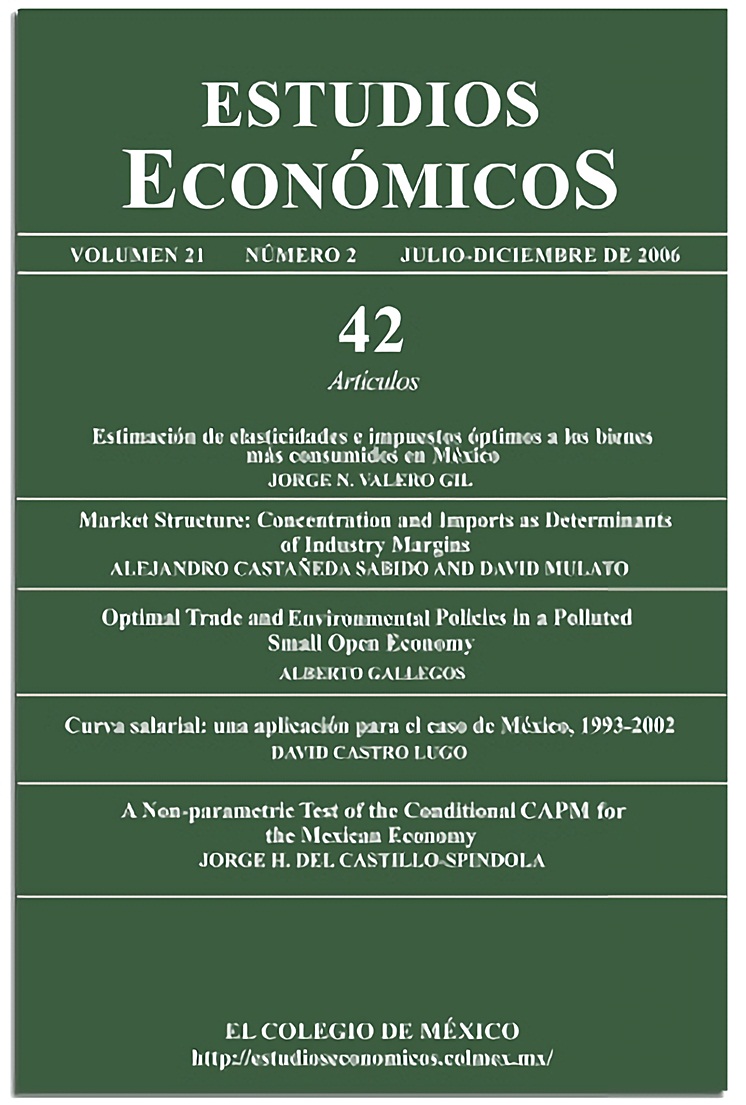Estructura de mercado: concentración e importaciones como determinantes de los márgenes de la industria
Publicado 2006-07-01
Palabras clave
- márgenes de precio-costo,
- penetración de importaciones,
- concentración,
- efectos cíclicos
Cómo citar
Resumen
Se analizan los determinantes de los márgenes de precio costo de acuerdo con el enfoque tradicional de organización industrial. Los márgenes de precio costo se hacen función de los índices de concentración y el grado de penetración de importaciones. Los resultados indican que las importaciones reducen los márgenes de precio-costo de la industria doméstica. En el periodo posterior a la liberalización comercial el impacto de la concentración disminuye. Con ajustes por comportamiento cíclico de los márgenes de precio costo, se muestra que los estudios de sección cruzada tienden a sesgar las estimaciones. Se distingue entre bienes durables y no-durables y se encuentra que la concentración no afecta el margen de precio costo de los durables.
Descargas
Citas
- Athey, Bagwell, and Sanchirico (2002). Collusion and Price Rigidity, (mimeo).
- Bain, J. S. (1951). Relation of Profit Rate to Industry Concentration: American Manufacturing, 1936-1940, Quarterly Journal of Economics, 65, 293-324.
- Bresnahan, T. (1989). Empirical Studies of Industries with Market Power, in R. Schmalensee and R. D. Willig (eds.), Handbook of Industrial Organization, vol. II, North-Holland.
- Collins, N. R. and L. E. Preston (1969). Price Cost Margins and Industry Structure, Review of Economics and Statistics, 51, 271-286.
- Domowitz, I., R. G. Hubbard and B. C. Petersen (1988). Market Structure and Cyclical Fluctuations in U.S. Manufacturing, The Review of Economics and Statistics, 70, 55-66.
- Domowitz, I., R. G. Hubbard and B. C. Petersen (1986a). The intertemporal stability of the concentration-margins relationship. The Journal of Industrial of Economics, 35, 13-34.
- Domowitz, I., R. G. Hubbard and B. C. Petersen (1986b). Business Cycles and the Relationship between Concentration and Price-Cost Margins, Rand Journal of Economics, 17, 1-17.
- Geroski, P. A. and A. Jacquemin (1981). Imports as a Competitive Discipline, Recherches Economiques de Louvain, 47, 197-208.
- Grether, J. M. (1996). México, 1985-1990: Trade Liberalization, Market Structure, and Manufacturing Performance", in M. J. Roberts and J. R. Tybout (eds.), Industrial Evolution in Developing Countries, Oxford University Press.
- Green, E. and R. Porter (1984). Non-cooperative Collusion under Imperfect Price Information, Econometrica, 52, 87-100.
- Haltiwanger J. and J. E. Harrington Jr. (1991). The Impact of Cyclical Demand Movements on Collusive Behavior, Rand Journal of Economics, 22, 89-106.
- Hall, R. E. (1988). The Relation between Price and Marginal Cost in US Industry, Journal of Political Economy, 96, 921-947.
- Jacquemin, A. (1982). Imperfect Market Structure and International Trade- Some Recent Research, Kyklos, 35, 75-93.
- McGahan A. M. (1999). The Performance of US Corporations: 1981-1994, Journal of Industrial Economics, 47, 373-398.
- Nadiri, I. M. and R. Prucha (1996). Estimation of the Depreciation Rate of Physical and R&D Capital in the US Total Manufacturing Sector, Economic Inquiry, 34, 43-56.
- Nelson, R. L. (1963). Concentration in the Manufacturing Industries of the United States, Yale University Press.
- Nelson, C. R. and R. Startz (1988). Some Further Results on the Exact Small Sample Properties of the Instrumental Variable Estimator, NBER TWP no. 68.
- Pugel, T. A. (1980). Foreign Trade and US Market Performance, Journal of Industrial Economics, 29, 19-130.
- Rotemberg, J. and G. Saloner (1986). A Supergame-Theoretic Model of Price Wars during Booms, American Economic Review, 76, 390-407.
- Solow, R. (1957). Technical Change and the Aggregate Production Function, Review of Economics and Statistics, 39, 312-330.
- Tirole, J. (1988). The Theory of Industrial Organization, MIT Press.

